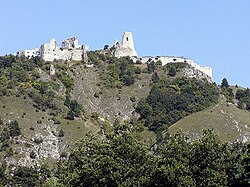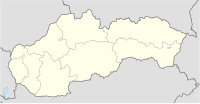Čachtice Castle
| Čachtice Castle | |
|---|---|
| Čachtice, Slovakia | |
 View of the castle ruins from the south | |
| Coordinates | 48°43′30″N 17°45′39″E / 48.725°N 17.760833°E |
| Site information | |
| Owner | Village of Čachtice |
| Condition | Ruined, Tourist Attraction |
| Website | https://cachtickyhrad.eu/en/ |
| Site history | |
| Built | 13th century |
| Built by | Kazimír of Hunt-Poznan |
| Materials | Limestone |
| Demolished | 1799 |
Čachtice Castle (Slovak pronunciation: [ˈt͡ʃaxcit͡se]; Template:Lang-sk, Template:Lang-hu) is a castle ruin in Slovakia next to the village of Čachtice. It stands on a hill featuring rare plants, and has been declared a national nature reserve for this reason. The castle was a residence and later the prison of the Countess and alleged serial killer Elizabeth Báthory.
Čachtice was built in the mid-13th century by Kazimir from the Hont-Pázmány gens as a sentry on the road to Moravia. Later, it belonged to Matthew Csák, the Stibor family, and then to Elizabeth Báthory. Čachtice, its surrounding lands and villages, was a wedding gift from the Nádasdy family upon Elizabeth's marriage to Ferenc Nádasdy in 1575.
Originally, Čachtice was a Romanesque castle with an interesting horseshoe-shaped residence tower. It was turned into a Gothic castle later and its size was increased in the 15th and 16th centuries. A Renaissance renovation followed in the 17th century. In 1708 the castle was captured by the rebels of Francis II Rákóczi. It was neglected and burned down in 1799. It was left to decay until it was turned into a tourist attraction in 2014.[1]
In popular culture
- Along with the Orava Castle, the Čachtice Castle was used as the location for Count Orlok's castle in Nosferatu.[citation needed]
- A slightly dressed up version of Čachtice is used for the exterior shots of Baron Gorc's castle in the 1981 Czechoslovakian comedy The Mysterious Castle in the Carpathians.[citation needed]
- Čachtice was used as the castle ruins set featured in the opening sequence of the 1996 fantasy movie Dragonheart by Universal Pictures starring Dennis Quaid.[2]
- Čachtice Castle was featured in the "Castle of the Blood Countess" episode of the ABC Family show The Scariest Places on Earth, as well as the August 2008 episode "Tortured Souls" on the SyFy channels series Ghost Hunters International.
- Juraj Jakubisko's 2008 film Bathory is set in Čachtice Castle, where some scenes were filmed.
Gallery
References
- ^ "História hradu". Čachtický hrad. Retrieved 2020-03-21.
- ^ "Castles and More Castles (Slovakia)". Iarelative.com. 1996-06-06. Retrieved 2012-09-15.
Further reading
In English:
- Craft, Kimberly (2009). Infamous Lady: The True Story of Countess Erzsébet Báthory. ISBN 978-1-4495-1344-3.
- McNally, Raymond T. (1983). Dracula Was a Woman: In Search of the Blood Countess of Transylvania. New York: McGraw Hill. ISBN 0-07-045671-2.
- Penrose, Valentine (trans. Alexander Trocchi) (2006). The Bloody Countess: Atrocities of Erzsébet Báthory. Solar Books. ISBN 0-9714578-2-4.
- Thorne, Tony (1997). Countess Dracula. Bloomsbury. ISBN 0-7475-2900-0.
In French:
- Périsset, Maurice (2001). La Comtesse de Sang. Pygmalion. ISBN 2-85704-700-2.
In German:
- Farin, Michael (2003). Heroine des Grauens. Elisabeth Báthory. Munich: P. Kirchheim. ISBN 3-87410-038-3.
In Hungarian:
- Bessenyei, József (2005). A Nádasdyak. General Press Kiadó. ISBN 963-9598-65-8.
- Lengyel, Tünde and Várkonyi, Gábor (2010). Báthory Erzsébet, Egy asszony élete. General Press Kiadó. ISBN 978-963-643-168-6.
{{cite book}}: CS1 maint: multiple names: authors list (link) - Nagy, László (1984). A rossz hírű Báthoryak. Kossuth Könyvkiadó. ISBN 963-09-2308-4.
- Nagy, László (1987). Az erős fekete bég: Nádasdy Ferenc. Zrínyi Katonai Könyv és Lapkiadó. ISBN 963-326-933-4.
- Nemere, István (2009). Báthory Erzsébet magánélete. Könyvmolyképző Kiadó. ISBN 978-963-245-193-0.
- Péter, Katalin (1985). A Csejtei várúrnő: Báthory Erzsébet. Helikon. ISBN 963-207-652-4.
- Rexa, Dezső (1908). Báthory Erzsébet Nádasdy Ferencné. Benkő Gyula Udvari Könyvkereskedése.
- Supka, Géza (c. 1940). Az átkozott asszony: Nádasdy Ferencné, Báthory Erzsébet bűnügye. Erdélyi Egyetemes Könyvtár.
- Szádeczky-Kardoss, Irma (1993). Báthory Erzsébet igazsága. Nestor Kiadó. ISBN 963-7523-26-X.
In Slovak:
- Dvořák, Pavel (1999). Krvavá grófka: Alžbeta Bátoryová, fakty a výmysly. Slovart. ISBN 978-80-85501-07-0.
- Nižnánsky, Jožo (2001). Čachtická pani. Media Klub. ISBN 80-88963-52-4.
External links
- The Bloody Countess? - Translation of Dr. Szádeczky-Kardoss Irma's job
- The Lies about Elizabeth Bathory - Inquest of National Geographic Channel
- Čachtice castle and the blood countess Alžbeta Báthory
- Slovakia Cachtice (Bathory) Castle (video)








